BKOOL Wireless ANT+ Trainer In-Depth Review

The BKOOL trainer is unique in the market in a number of ways. It marks the first trainer I’ve reviewed that includes an all-you-can-eat flat-rate approach to riding videos shot outdoors, while indoors. It’s also the first resistance controlled computerized trainer at 500€. And, because of that fancy little symbol (Euro) you see there – it’s also the first unit I’ve reviewed that only available today in Europe (Update: Now available worldwide).
But, they’re working to change that – so let’s dive into the unit a bit and see how it enters into the larger trainer market.
Back in October the folks at BKOOL sent me out a unit to try out. Ultimately, the unit will go back – like everything else I test. All products are returned to the companies (really, I simply don’t have room for this many trainers even if I wanted them).
Speaking of which, like all my reviews, they tend to be pretty in depth (perhaps overly so) – but that’s just my trademark DC Rainmaker way of doing things. Think of them more like reference guides than quick and easy summaries. I try and cover every conceivable thing you might do with the device and then poke at it a bit more. My goal is to leave no stone unturned – both the good and the bad.
Lastly, at the end of the day keep in mind I’m just like any other regular athlete out there. I write these reviews because I’m inherently a curious person with a technology background, and thus I try and be as complete as I can. But, if I’ve missed something or if you spot something that doesn’t quite jive – just let me know and I’ll be happy to get it all sorted out. Also, because the technology world constantly changes, I try and go back and update these reviews as new features and functionality are added – or if bugs are fixed.
So – with that intro, let’s get into things.
Unboxing:
Here’s how you’re going to start off the whole BKOOL system experience – with the unit still fresh in the box:

From there you’ll go ahead and take the main white box off, which leaves you with the innards hanging around. That brown box to the right in the photo below isn’t related. It’s just photobombing the picture.

I continue to be happy with trainer companies that don’t require me to put any trainer parts together myself in their final packaging – and this is true of the BKOOL as well. The whole thing is pre-assembled:

Let’s quickly dig through what’s in the box.

First up, is a trainer skewer. If you don’t already have a trainer skewer on your bike then this takes care of that problem. If you’re like me and already have one you can continue to use that skewer instead. Nothing special about this skewer. The reason you do need a trainer skewer though is that most regular skewers have plastic ends which will otherwise break when you try and lock it in the trainer. And that would be bad. Very bad.

Inside you’ll also find a dedicated ANT+ cadence sensor in there. Note that this is a cadence-only sensor, and not a Speed-Cadence combo sensor. From my testing, I can pair to a speed/cadence combo sensor, but it actually doesn’t correctly seem to pickup the cadence portion. Kinda silly since that’s the most common sensor on earth aside from a heart-rate strap. (Update: A later software version has fixed this issue, combo speed/cadence sensors now work.)

Anyway, onto the trainer itself:

This is the resistance unit. It’s where all the magic happens. Unlike most trainers it’s actually firmware updatable, which you’ll likely notice when you first install the software.
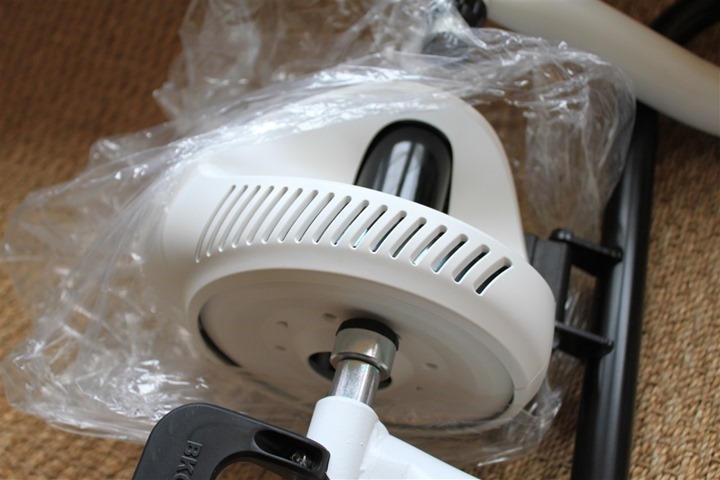


The trainer does require external power. You’ll see that the below is a European plug, which is logical since it’s only sold in Europe today. Though, the unit accepts 100-240v, so it will work just fine with a 99 cent converter in the US. You can also see the standard ANT+ USB stick in there too, which is how the trainer communicates with the computer.



In addition to the trainer stand, you’ve also got a front wheel stand. Nothing special, but it does the trick and keeps your front bike wheel pointed forward.

Ok, with everything all unboxed, let’s get onto the setup piece.
Hardware Setup:
The first thing you should do is to put some sort of trainer mat down. This is beneficial not only to protect your floor (unless you’re in a garage), but also because it typically reduces the sound of the trainer and vibrations. Once that’s done, plunk the trainer down on top of it:

You’ll notice on the back there’s a spot to plugin that power adapter they gave you. Now would be a good time to do so:

We’ll tackle that USB port you see there a bit later.
You’ll notice the trainer itself doesn’t actually have any support beams for the clamp system. If there’s not a bike there – it’ll just rest on itself:

See how if I then start to pickup the clamping portion, it rotates forward:

Now, I’ll continue rotating it forward until it aligns with my rear bike wheel (I’m assuming you’ve put that trainer skewer on there already).

Go ahead and clamp it in. The left system will lock it all in place in a split second. Probably one of the easiest trainer clamps to date I’ve seen in this area. Note that the clamp may feel a bit tight when you try and lock it. Just keep pushing, it won’t break. Well, hopefully anyway.


Once you’ve got it clamped in place, the rear wheel will simply rest against the roller. No downward pressure here or tightening the roller. Your body weight will do that.

What you do what to do however is ensure your tire is inflated properly. For most tires, that’s usually about 120psi. In my case, for these particular tires that was all the way up to 160psi.

Now lots of folks ask about dedicated trainer wheels. Trainer wheels are sorta a ‘religious’ topic. Some love them, others don’t bother. I fall into the ‘don’t bother’ category. In most cases you’re likely going to replace your tire (the rubber part) about once a year or so anyway from a tread perspective. At least if you’re putting on a fair number of miles. For me, the cost of tires are generally pretty cheap ($20-$40) – compared to the hassle of swapping out wheelsets or tires onto wheels each time I ride on a trainer (2-4 times a week). Again, to each their own.
I will point out however that I was surprised with how much tread comes off on this unit. Now perhaps because the unit is stark white – whereas every other trainer is dark, and no other trainer has a natural ‘catch’ for the material. But I thought it made for an interesting photo.

So, everything is setup when it comes to the physical unit – let’s move onto the online piece.
Online Setup:
The primary interface to the BKOOL as far as preparing workouts goes is actually online. In fact, the platform is fully integrated into an online account where your profile information, planned rides, and ride history is stored. It’s through that interface that you’ll add and create sessions that you’ll ride later on the trainer and desktop software. Think of the online site as a shopping cart for trainer sessions.
Within your online profile you’ll also configure display options as well – such as metric vs. statue, time zones and languages.
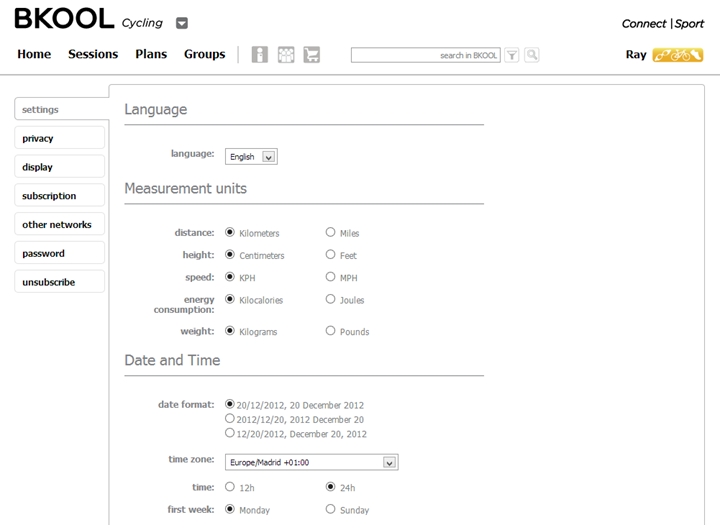
There’s really a ton of options here, more so than most online trainer integrated platforms that I’ve seen.

Of course, probably the biggest decision you’ll be making is just which subscription level you want to buy into. Unlike most trainer platforms, BKOOL doesn’t charge upfront for the trainer software, or videos or courses. Instead they have a Netflix model where you may monthly for unlimited access.
Essentially, the core functionality difference between Silver and Gold is the ability to use Real Videos. And quite frankly, that’s more than worth the 5€ euros a month (about $6-7US). Keep in mind that most trainer platforms charge about $100US per video. This is unlimited videos (to the extend their library has anyway).

With that, let’s dive back to the client software. You’re going to install a small piece of software called BSIM on your computer. This software has two components. The first is a desktop tray app that sits there and watches your online account for changes and synchronizes them to your locally installed desktop client. This includes your scheduled rides, history, etc…
Additionally, this software enables firmware updates to the BKOOL system.

Once you’re done setting it up online, you’ll want to be sure that you’re firmware is up to date. The trainer itself supports firmware updates, and you do so via a USB cable. Now the only complaint I have here is that the USB cable they give you is pretty short. In my case, the computer is near the front of the bike. So that means I needed an USB cable extender to make it all the way to the back of the bike. I suppose I could have just dragged things around – but having an extender cable is always handy.

You can see once I’ve connected the cable that the BSIM tray and update software will detect the connection to the trainer and illuminate the nifty icon in the graph:

You’ll also notice that the ANT+ USB stick is plugged in as well. This comes with the BKOOL platform, and enables wireless connectivity to the trainer. The USB cable to the trainer is only for firmware updates, whereas the USB ANT+ stick is used for continuous operation (in other words it always needs to be plugged in). You can watch the BSIM utility to see the state of workouts that need to be sent to the server. Typically this happens instantly, but if for some reason your internet is down, it’ll just queue up. Fear not, as long as you have some sessions sync’d to the trainer, you don’t need live internet connectivity for all tasks.
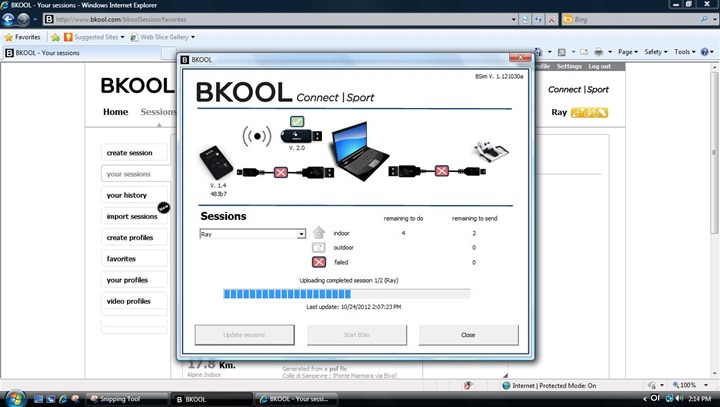
With everything set, we’ll go ahead and open up the actual BKOOL application, which is where we can start our sessions from.

You’ll see it has three main areas. The first is single player, then multiplayer, and then configuration. We’ll tackle configuration first since the options are pretty limited. Remember that most of the options you actually configure online ahead of time.

What you see above is about all you get within the app itself (except the ability to toggle Google Earth on/off, which is not shown in the above screenshot). The only additional accessible option is to pair devices, which you can do via the ‘Indoor Pairing Devices’ screen, which takes you to the below:

A pretty straightforward pairing menu, with your common ANT+ sensor types. Note that it doesn’t pair to an ANT+ power meter, instead, it will only pair to the heart rate and speed/cadence sensor types. Also note that it’s only reading sensor data from those, and doesn’t transmit the data back out to ANT+ head units. Meaning, your Garmin or similar device won’t be able to pickup signals from the BKOOL. Personally, I’d love to see this – as it really makes for a much more flexible training platform because it allows end users to control their training data on the device of their choice.
Back to the main menu we’ll go.
From here, we dive into the Single Player options. This will now show sessions that are either ‘in queue’ for me to complete (ones I’ve added online), or, ones that I’ve marked as favorites. You can see some of the sessions in this flipbook style screen contain simple non-graphical workouts (like the one labeled Barcelona), some are Real Videos (like the one to the right), and some are more game-like – such as the Velodrome one.

I’ll dive into each of these types in a few sections.
Finally, we’ve got the Multiplayer option.

Once in here you’ll see the available multiplayer sessions currently being hosted on the server. These can be scheduled ahead of time, or launched at any time. In the case of the above, I simply clicked in to see what was available and was able to then join the above noted session with two other riders in it. Again, I’ll cover all this in a minute as we dive more deeply into those sections.
Trainer Accuracy (Power/Wattage):
Before we dive into all the details on how the different trainer modes work, let’s take a short detour about accuracy, as it’s one of the most common questions I get about the trainer.
In vast majority of situations, most high-end trainers are highly accurate (speaking about the industry as a whole). This is primarily because there are far less variables than on-bike power meters – such as temperature drift, part configuration, or limitations on space. Typically when I measure accuracy I’m doing so against multiple on-bike power meters. In some cases, other 3rd parties have long-since established accuracy of a trainer (i.e. the CompuTrainer), so doing so in a less scientific manner than those testing entities is a bit silly. But for newer entrants on the block where such data doesn’t exist – I try to take my best shot at it.
The challenge though with the BKOOL is that it doesn’t actually save your power meter data into a downloadable format. Thus making the whole process a wee bit more difficult. During the ride, and upon completion of the ride it provides your instant/current power, as well as your overall averages. So my initial comparisons were fairly limited in that I was just looking at visual tracking comparing power meter values on my bike (via head unit) with those on the trainer via the screen.
And in general, these averages were astoundingly close. I say ‘astoundingly’, because unlike most trainers- the BKOOL trainer does not have any calibration mechanism. There is no standard roll-down test like those offered on most other electronic trainers. Thus, they can’t compensate for differences in tire pressure, or other measurement accuracy factors. So I was highly skeptical as to how accurate the trainer would actually be.
But after getting on it and placing the power meter display right up next to the power meter numbers from the BKOOL, I was blown away at how well they tracked:

In fact, they were almost always within 5%. I found that they were closest on climbs (lower speed efforts), and they drifted more at higher speed efforts such as descents. Constant efforts on flats would be pretty much treated the same as climbs – assuming you weren’t just light-pedaling.
Ride after ride, the numbers ended up surprisingly close:
Below: Power2Max at 210w, PowerTap at 210w, BKOOL at 204w:

Below: BKOOL at 208w, PowerCal on FR910XT 208w, PowerTap on iPhone at 213w, Power2Max (older) on Edge 800 at 212w

(Remember: All power meters displayed here have accuracy rates +/-2% – thus it’s possible any one or multiple of them is inaccurate. All are calibrated at the start and 10-minute markers. Except the PowerCal, it doesn’t really do calibration in this sense.)
But, I was curious – how close were they when it came to instant-power at a given point in time if I lined up the two units on paper in graph form? So I reached out to the BKOOL folks and asked if they could export out my ride files. The data is all there behind the scenes, it’s just that today they don’t have an export function on their site (they have committed that it’s a feature coming soon). No problem they said, and sent me the XML files.
Unfortunately, you know you’re in deep trouble when even Golden Cheetah can’t open up your cycling file. While this was fairly straight forward XML, it’s not something GC was able to parse (it’s what I use for all data comparisons as it allows me to normalize the data against other sets). I’m going to poke at it a bit more to see how the second-by-second data looks. But hopefully, they’ll get the XML function up and running and export to something like .TCX which everyone supports (also an XML variant, but one that’s effectively an industry standard in the cycling world).
Update June 4th, 2013: The BKOOL System now supports updating of files to the following formats: Indoor Sessions: .fit Outdoor Sessions: .fit, .tcx, .gpx (Shortly coming to both: .HRM) – it does require a gold subscription however.
A few other things I noticed. First is that if you do a standing climb (or any standing), your accuracy immediately goes out the window. The reason being is that the BKOOL trainer depends on your weight on the bike to hold traction down on the rear roller. So you see that you’ll get highly underreported numbers (i.e the BKOOL might report 125w, and I could be doing 400w).
The wheel doesn’t lock down onto the roller, rather, it floats based on your body weight. By standing up, you shift your weight away from the rear wheel (since your seat is roughly above your rear wheel), you’re decreasing force holding the whole thing together. As soon as that happens I see both skipping of the trainer wheel, as well as loss of accurate power meter figures.
Again, the primary purpose of the BKOOL trainer is keeping you fit while training indoors, and doing so at a much lower price than others – focused on entertainment. Thus, at half the price of the other units out there, I expect less on the accuracy side. But even with expecting less, it certainly exceeded my expectations.
A detailed look at using the BKOOL Trainer in different modes:
There are several types of workouts that you can execute on within the BKOOL training platform. Each one offers a slightly different experience depending on whether you’re aiming to train somewhat solo, or train more in a group setting. And then from there, the experience differs whether you’re looking to replicate something found in real life, or just looking to get in a good workout.
I’m going to walk through each of the types of sessions that you can emulate.
Now all of these session types are pre-configured online ahead of time. Meaning that in order for you to ride the trainer you have to have some forethought and prepare your ‘Session’ ahead of time. However, you can do what I do which is to mark all of them as favorites. That way if I happen to forget, I can still access one listed as a favorite. Otherwise, once a session is completed it’ll be removed from the home screen on your trainer.
Again, starting with the online piece first, via the BKOOL website. All sessions (think planned workouts) start out via the first two steps, which are selecting “Create Session” from the left-hand pane, and then selecting the ‘Indoor’ session type. From there, you’ll choose individual. Of course, I’ll talk about multiplayer a bit later.

Now that the baseline is set, let’s dig into each of the options presented to you after the above screen.
Workout Session Type: Individual
Workout Category: BKOOL Session
This particular session type is based on me first selecting an ‘Indoor’ workout, which means I’ll be executing it on my trainer (versus on my phone for outside workouts). From there, I can choose the elevation profile of the workout. Essentially you’re creating a filter for the system to find the perfect route for you.

After specifying the elevation profile, you can then specify the duration in either time or distance. I’ve found that the minutes estimates are actually fairly reasonable. Occasionally I’ll beat them by a couple minutes, but they tend to work out fairly well.

Note how if I change from a flat to an alpine workout – both with 50 minutes, it knows to shorten the duration. Alternatively, I can just set a given time by selecting the bottom.

Once you’ve clicked ‘Continue’, it’ll come back with a few options, depending on the distances provided. In the below screenshot, I changed the length of time to 15 minutes:

Lastly, it’ll allow me to personalize the session. Again, session essentially means ‘Workout’ in BKOOL terminology:

Above you can see the session settings on the main tab – such as a time trial versus free ride, as well as being individual or multiplayer.
On the opponents tab, I can go in and add virtual opponents and specify how good they are. There are varying levels from Elite to Professional to different more age-group focused levels.

I can create alerts, though strangely the values are locked to 5 increments (i.e. 135, 140, 145). This is moderately annoying as most peoples heart rate zones (or any zones) don’t tend to be locked to a given 5-step increment (especially heart rate). On the bright side, the warm-up and cool-down options are appreciated.


By clicking the ‘Change Terrain’ tab, I can change when it looks like virtually. In my case, I’m going with Dirt. It’s the fall (ok, it was when I started writing this) – cyclocross season and all. Don’t overthink this tab, it just changes the color of the elevation profile. It’s not doing anything fancy.

As noted, the only thing this really does though is just change the graph color.

Lastly, we have a map of where this particular route was actually pulled from. Remember that it’s simply selecting known routes, and thus, every route comes from somewhere on earth.

Once we press Save Session, it’s ready for us to ride. From there I’d switch to the trainer app and startup the single-player session and choose the session above.

Once you’ve selected the course to ride it’ll first give you a 10-minute warm-up. You can cancel this at any point by simply not pedaling. In the case below, you’ll see a slightly different course shown, but it’s the exact same workout format as above. Once you’re ready to start riding after cancelling the warm-up, you’ll be in the regular mode and ready to begin.

As you ride you’ll find your metrics shown along the bottom of the screen, as well as in the upper right corner.
Bottom (from left to right): Current heart rate (BPM), Average Heart Rate, Current wattage (Watts), Average Watts, Current Speed, Average Speed, Current RPM, Average RPM, Current Calories Burned, and Calories/Hour.
Top right: Current time, then estimated time to completion, followed by distance to completion, followed by current incline/decline.

You’ll notice above that the text is red in the km/h box. That’s because I’ve just crested a hill and am going downhill and am currently exceeding the estimated pace for this particular workout. Anytime I’m above or below the estimated paces I’ll let me know. And also, as noted above, you can change this all to statue instead of metric (MPH instead of KPH).
Within this workout mode, this is about all you’re going to see. It’s about as simple as it gets. You can see above a random photo I took showing the current power (206w per BKOOL) compared to the power on the Power2Max (214w). Pretty good.

Once you’re workout is complete, you’ll get a bit of a summary screen. All of this information is also available later on online, as the workouts are synchronized just after completion.
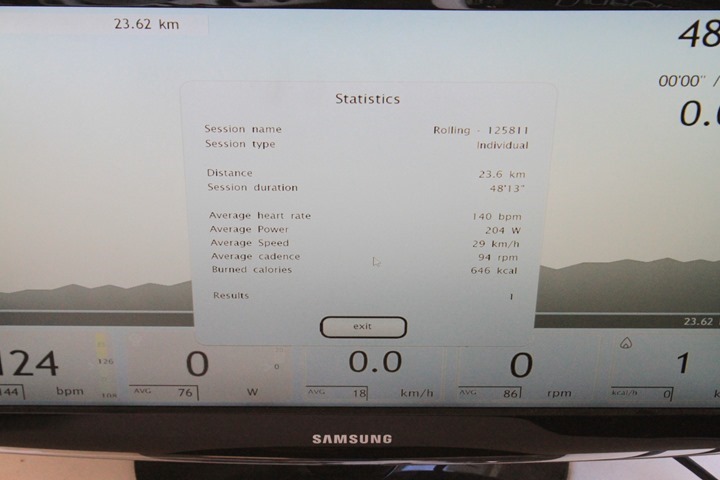
Workout Type: Velodrome
In this category, you’re on an emulated Velodrome. To start off, you’re going to specify either how many laps, or how many minutes:

From there you can configure how the session will work. Be it free ride (start and go), time trial (only shows you opponents times at various points), or Running Start (allows you time to build up prior to start).

I can add either automated opponents, or take ones from the right hand side and just simply drag them over:

Finally, I can specify alerts like above, but I can’t change terrain or maps (meaning, there’s no ability to switch to different velodromes).
Once that’s done my session is scheduled and ready to go:

Once I had it queued up on my computer, I was ready to roll:

As you enter the session you’re able to start with a warm-up, as all BKOOL sessions allow for.

It’s bizarre – I never though I’d actually enjoy riding in a computerized velodrome. But…this was surprisingly addicting. No, really, for real. I set out to just do a quick test ride of this section since I didn’t think it would interest me. But sure enough, I ended up doing a whole bunch of these for fun.

In this particular instance, the robot kicked my butt. But given I was screenshotting and taking photos at the same time, I don’t feel too bad. Next time robot…I’ve got ya.
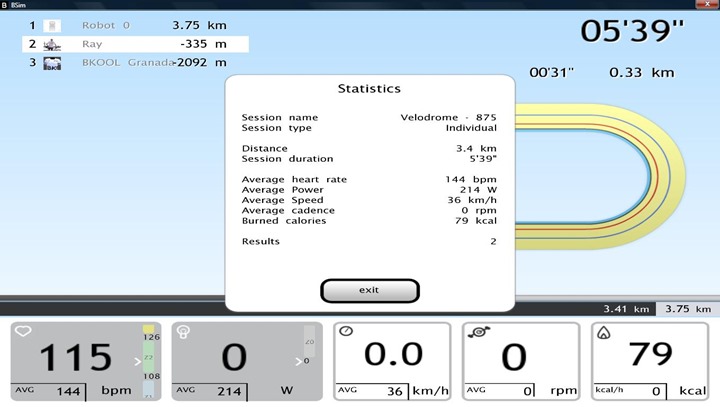
Afterwards, you’re afforded a cool down.
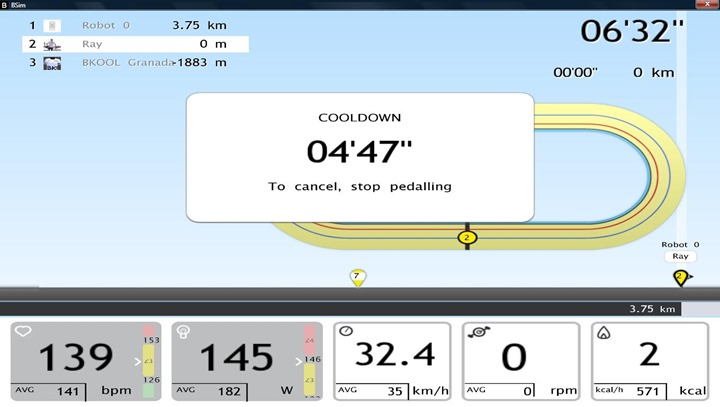
Workout Type: GPS Route
This allows me to utilize a GPS route from a past or previous activity – be it one that I’ve recorded myself, or one that someone else has uploaded.

I can then specify if I want fixed time or fixed distance. I prefer distance, so I can race against previous attempts of my own:

At this point it takes me to here, which makes no sense:

Now, in this mode by default the end resultant isn’t any different than the previous section. The only training difference is that you’re riding against a known GPS route somewhere in the world. Otherwise, it’s just like above.
But, the newly released functionality this week that changes this is the Google Earth mode. This mode enables you to see the course as if you were within Google Earth. I played around with it a bit on one of my GPS routes (oddly enough, from running this past weekend in a 10K race), but it provided a good completely random sample of how things might look.


In general, the terrain was pretty sparse. The blue line is my current/planned track. You can clearly see the roads and some terrain, but it’s pretty slim.

It seems as though I may have picked a fairly sparse area (though, this is pretty much in the heart of Paris). You can however see some buildings off in the distance – for example, the Eiffel tower. There aren’t any configuration options to increase density, so it’s a bit of a ‘however is shows up’ experience. Since this feature is just now available (literally in the last day), I’m looking forward to seeing them fine tune it.
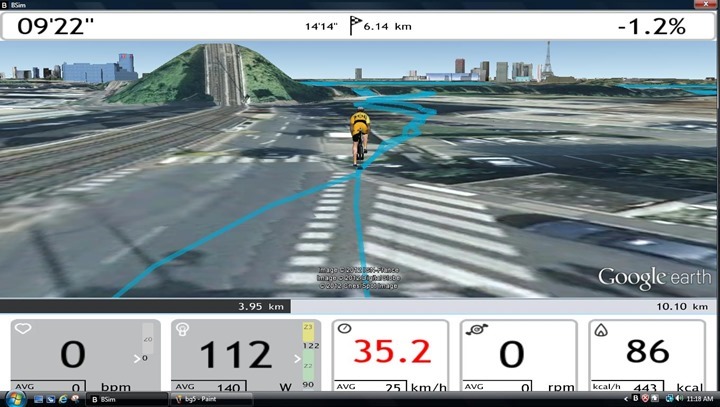

Here’s a video they put together, that shows you the potential in a few others areas. As you can see, some areas are solid with great coverage, and other areas are a bit slim:

Now I’ve personally never found too much excitement in the current implementations (across all vendors) in Google Earth trainer riding, it’s just not clean enough yet for me – it doesn’t pull me in. But, to each their own. I’d much prefer to see real life videos. Which…just happens to be the next section. 😉
Workout Type: Real Videos:
Videos are perhaps the most valuable use of the BKOOL Training system, simply because they’re all effectively free after you’ve paid your monthly subscription. Like I’ve said elsewhere – a bit of a Netflix approach.
To start off with, we’ll choose ‘Video’ from the list, and then dive into ‘Find videos’.

Then I’ll specify a distance or time based duration parameter. After which we have two options. The first option will change the speed of the playback based on your cycling speed. You go slower, the video goes slower. The second will simply take you along for the ride. Think of the second option as being tied via a rope onto the back of a car.

Once you’ve selected your video playback methodology of choice it’s time to select the video itself. Here’s a handful of options shown based on the parameters I’ve entered. You can see a quick screenshot on each one. In general, you’ll find most videos are Spain based – likely due to the company being based in Spain.

After selecting the video, you can go ahead and configure the usual options around opponents/alerts/etc… along the bottom.

Finally, once you’re done you’ll want to click ‘Save Session’ to save it into your library.

Once that’s completed, you’ll be able to open it up on the desktop application and choose it (or any other video you’ve saved) as a session to ride:
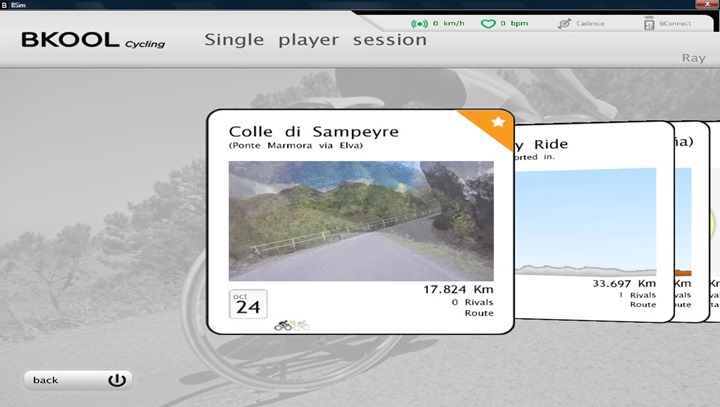
Like other sessions, there’s an initial warm-up that’s offered. After which, you can ride as normal.
The details shown on the screen are largely the same as other workout types within the platform. The only difference is that the text boxes have a transparent aspect to them to avoid overshadowing the video too much:
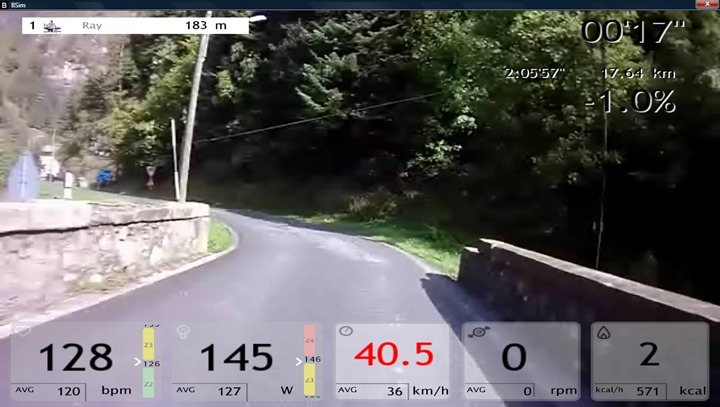
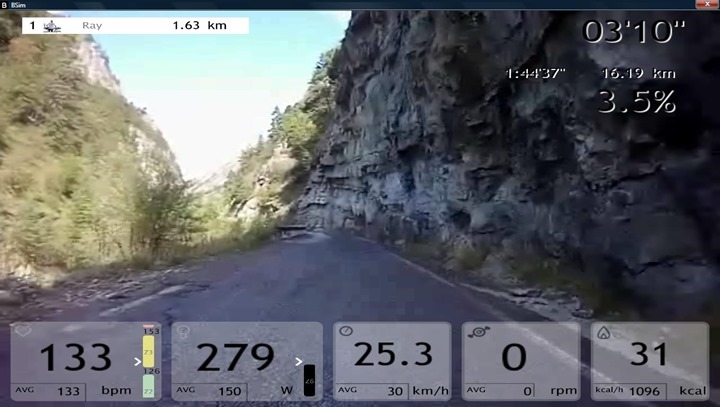
Overall, I’m fairly impressed with the videos. The above screen may not be the pinnacle of video quality, but you’ll see in later shots, it’s more than sufficient.
Below, you can see my setup where I have the video off to the side, easily within view.

As I noted earlier, I think the real strength of the BKOOL system is the unlimited videos at this price point. Now, most of the videos are within Spain, so I do believe a broadening of the video library would be ideal – inclusion of races, and other non-Spanish events would help it to appeal to a more worldwide audience.
Workout Type: Multiplayer:
Last but not least, multiplayer. Multiplayer enables you to ride against other riders, either within a video setting or one of the other session types.
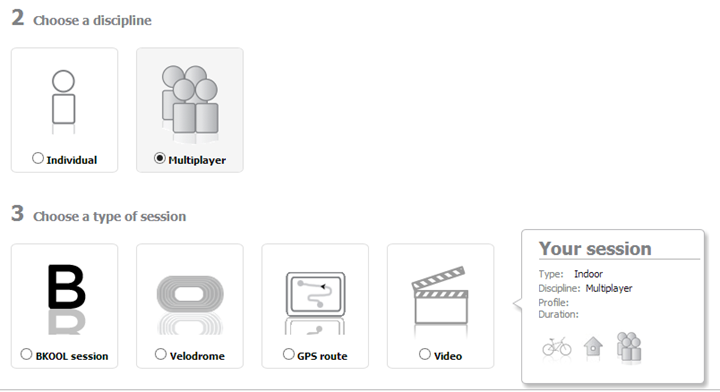
In this mode, you can choose all of the same workout types as before. Once that’s complete, you’ll specify the length of the activity in either distance or time – just like before. Ultimately, that’ll give you options to choose from:

Finally, you’ll specify a time for the session to start. For the most part, these will be created just ahead of the actual ride time, as you can’t specify dates in the future – just times in the future.

Once that’s all set, you’ll go into your multiplayer session and find the active sessions which you can join:

After starting your session, you’ll see your ranking against other riders in the top corner. You’re position along with how far back is displayed:

If other riders join, they’ll be added into the screen as well. For the most part though, the only thing that’s different in this mode versus single-player mode is that you see the small ranking chart in the corner.

The one aspect that was a bit of a bummer was that there’s no indication overlaid onto the screen that you’re coming up onto someone or about to pass them. Meaning, no virtual cyclist is displayed. It’s merely that you overtake the person listed within the rankings.
Take for example the below shot. At this point I’m either overtaking or just overtaken another rider. But beyond the ranking chart – nothing else is shown within the video. Obviously, since it’s a real video from outside you can’t exactly just put a real person there. But it would be nice if there was some sort of overlay that shows as you pass a virtual cyclist – especially useful if two cyclists are pushing hard and trying to edge each other out.

Since we’re on the multiplayer feature, now’s a good time to mention groups. Now groups aren’t explicitly part of multiplayer, but they’re roughly related. Groups are ways that people can compete together or against each other in a team fashion.
You can create a new group within the platform, or you can join other groups. You can see some of these groups below have hundreds of members on them.

Groups are typically tied to events – like a league. In the case of the La Vuelta 2012 league, the riders are given a set time period (Days) to complete various portions of stages – ultimately helping them in rankings:

Overall, it’s a cool concept and one that’s clearly caught on within the groups – given the pretty impressive participation numbers – there were nearly 100 people that finished this one particular stage. The stages are in more reasonable bite-sized chunks (picking the best parts) than the full stages in real life. But of course that’s up to the race organizer, so you could make them just as long and painful if you wanted.
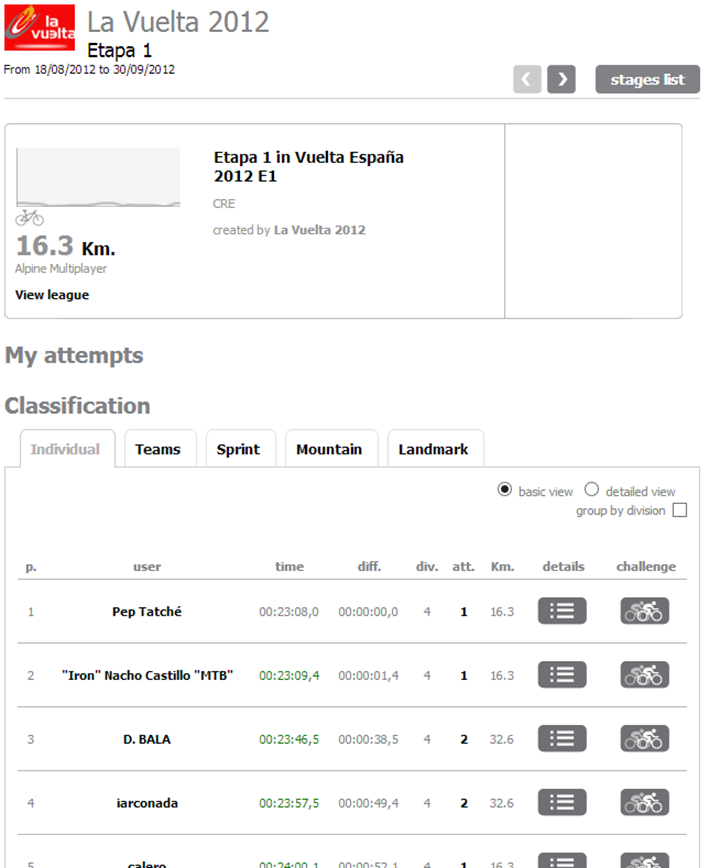
Other Workout Types:
Finally, just to briefly mention that in addition to everything else I’ve mentioned above, you can also go ahead and do some basic FTP type tests within the platform also:

From there they’ll help you define your various zones and then display those zones within the workouts.
Importing GPS tracks into BKOOL:
In addition to utilizing the existing courses and routes within the BKOOL platform, you can also import GPS tracks and re-ride them. For example, I could import the track file for Ironman France (Nice) that’s freely available from any number of courses (MapMyRide, Garmin Connect, Strava) and then create a session from it. Further, I could then re-ride a Google Earth session based on that, as seen above.

Importing Sessions (other activity data):
Importing sessions is slightly different than importing tracks. Importing sessions is used when you want to add an outside ride (or from some other device) into your BKOOL history. In this way, it’s offering a method to import in something like a race into the BKOOL training log. Essentially anything recorded outside the BKOOL system.

In doing so the one minor benefit here is that you can then also ride these courses later on. Further, I’ll point out that I’m fairly impressed with the parser they added, it’ll consume just about most of the major devices out there today (Garmin/Polar and their various file formats). Not too shabby.
Online/Ride History:
At present, the only method for viewing history is doing so online, and it’s somewhat limited. Within the online site you can dive into your past rides, and get high level graphical information about the ride. Additionally, you can also get some baseline metrics such as speed/distance/power and heart rate. You’ll dive into the ‘Your History’ page, and you can use a basic calendar view to divide up weeks/quarters/years and look at the results within that. Take for example this week back in October:

From there I can click on a given activity and get more detail about it. Along the side of the activity I have little pop-outs that will change the size of the graph, display more detailed information (such as below), and show zone information.

If I remove the pop-out, you can see the graph below it. I can also expand the graph to full screen:

In addition to seeing my own history, I can also create associations (friends) with various folks on the platform. In doing so I see their activities in my feed, sorta like a Facebook or Twitter feed. It works fairly well – and offers a good incentive to keep from slacking off when said friend does daily multi-hour rides….

In general the level of detail in history is sufficient for basic logging purposes and the ability to remember roughly how you did on a given activity.
However, the real limitation here is that they don’t support any exporting of data out of the site. This is a pretty significant limitation, as you can’t then export the data to other platforms (Training Peaks, Strava, etc…). I pushed them a little bit on this, and it sounds like they’ll be offering it shortly. Their primary goal was getting out this week’s Google Earth update, and now that that specific development effort is behind them, they’ll be working next to add an export mechanism for activities.
Update June 4th, 2013: BKOOL has now added export functionality in the following formats: Indoor Sessions: .fit Outdoor Sessions: .fit, .tcx, .gpx (Shortly coming to both: .HRM)
Trainer Market Comparison:
You can utilize the below comparison table that’s dynamically updated over time (so as features change via firmware) to compare the different trainers that I’ve reviewed. Note the key part being ‘I’ve reviewed’. There are no doubt many other great trainers on the market, it’s just that if I haven’t reviewed it, I don’t feel right including it based on some marketing fluff.
Also, as you’ll probably notice, these are higher end trainers. If you’re looking for lower-end options, see my general trainer recommendations post.
| Function/Feature | BKOOL Trainer | LeMond Revolution | Wahoo Fitness KICKR V1/2013 | Tacx Bushido | Kurt Road Machine (with inRide) |
|---|---|---|---|---|---|
| Copyright DC Rainmaker – Updated April 29th, 2021 @ 8:10 am New Window | |||||
| Price for trainer | €500/$650 | $499 | $1,199 | $940 | $199 + $340 |
| Trainer Type | Direct Drive (no wheel) | ||||
| Available today (for sale) | Yes | Yes | Yes | Available today | Available today |
| Availability regions | Global | Global | Global | Global | Global |
| Wired or Wireless data transmission/control | Wireless | Wireless | Wireless | Wireless | Wireless |
| Power cord required | Yes | No | Yes | No | No |
| Flywheel weight | 12.5lbs/5.7kgs | ||||
| Includes cassette | Yes (11 Speed SRAM/Shimano) | Resistance | BKOOL Trainer | LeMond Revolution | Wahoo Fitness KICKR V1/2013 | Tacx Bushido | Kurt Road Machine (with inRide) |
| Can electronically control resistance (i.e. 200w) | No | No | Yes | Yes | No |
| Includes motor to drive speed (simulate downhill) | No | No | No | No | No |
| Maximum wattage capability | 1,200w | 2500W @ 30mph | – | 3,000w | |
| Maximum simulated hill incline | 15% | Features | BKOOL Trainer | LeMond Revolution | Wahoo Fitness KICKR V1/2013 | Tacx Bushido | Kurt Road Machine (with inRide) |
| Ability to update unit firmware | Yes | PowerPilot Yes | Yes | Yes | inRide Yes |
| Measures/Estimates Left/Right Power | No | No | No | No | No |
| Can directionally steer trainer (left/right) | No | No | No | No | No |
| Can simulate road patterns/shaking (i.e. cobblestones) | No | Accuracy | BKOOL Trainer | LeMond Revolution | Wahoo Fitness KICKR V1/2013 | Tacx Bushido | Kurt Road Machine (with inRide) |
| Includes temperature compensation | No | Yes | Yes | – | No |
| Support rolldown procedure (for wheel based) | No | No | Yes | Yes | Yes |
| Supported accuracy level | +/- 10% | +/- 5% | +/- 3% | – | +/- 2% | Trainer Control | BKOOL Trainer | LeMond Revolution | Wahoo Fitness KICKR V1/2013 | Tacx Bushido | Kurt Road Machine (with inRide) |
| Allows 3rd party trainer control | Yes | No | Yes | No | Yes |
| Supports ANT+ FE-C (Trainer Control Standard) | Yes | ||||
| Supports Bluetooth Smart FTMS (Trainer Control Standard) | Yes | Data Broadcast | BKOOL Trainer | LeMond Revolution | Wahoo Fitness KICKR V1/2013 | Tacx Bushido | Kurt Road Machine (with inRide) |
| Transmits power via ANT+ | No | No | Yes | No | No |
| Transmits power via Bluetooth Smart | No | No | Yes | No | Yes |
| Supports Multiple Concurrent Bluetooth connections | No, just one | ||||
| Transmits cadence data | No | Purchase | BKOOL Trainer | LeMond Revolution | Wahoo Fitness KICKR V1/2013 | Tacx Bushido | Kurt Road Machine (with inRide) |
| Amazon | Link | N/A | Link | Link | Link | DCRainmaker | BKOOL Trainer | LeMond Revolution | Wahoo Fitness KICKR V1/2013 | Tacx Bushido | Kurt Road Machine (with inRide) |
| Review Link | Link | Link | Link | Link | |
Remember to click the ‘Expand Results’ button as it’ll show a gazillion more rows than the quick preview above.
Summary:
Overall I’m fairly impressed with the BKOOL trainer given its price point. When I first heard of it and saw it at Interbike, I wasn’t convinced there was a market for a trainer that had limitations around lack of calibration options. But once I got it and started playing with it, the accuracy is close enough for most users needs. No, it’s not 100% perfect, but it’s pretty good for the money.
Further, this trainer ultimately isn’t targeted at the power meter junkie. From a price point it’s targeted at folks that want a way to pass the time away during the winter on a trainer. It has a good collection of videos and rides, and the ability to import GPX rides into Google Earth means you can download anything you find on sites like MapMyRide and Garmin Connect. Which is pretty much any ride/race/route on earth.
From a price standpoint, at 500€/$650US, it’s a good buy. But how does it compare with more expensive trainers? Well, aside from accuracy there’s a lack of graphics polish that’s present in other platforms (for example Tacx and CycleOps). The BKOOL graphics seem a bit sparse, be in in simple menus or just general views while riding. So if you’re comparing a Tacx Bushido to this unit, no, they aren’t in the same league. Like Minor League to Major League ball. But at the same time, with the Tacx system you’re paying for every video you ride, whereas here it’s all you can eat. And on the CycleOps system while the videos are all you can eat, you’re still paying upwards of $349 for the initial software buy-in (plus nearly double the cost of the unit itself). It’s simply a game of choices and budgets.
Pros:
– Considerably cheaper than most trainers in this category
– Good blend of entertainment and training details
– Ride videos are all free with monthly package
– Accuracy is actually pretty darn good, despite lack of calibration
– Ability to join race leagues, teams, competitions (and compete online)
Cons:
– No roll-down/calibration procedure available for power meter
– Can’t export workouts (Update: As of June 4th, 2013, added)
– The online site graphics are a bit rough
– The desktop software is fairly limited in configuration
With that, thanks for reading! As always, feel free to leave comments/questions below and I’d be happy to try and answer them as best as possible.
Found this review useful? Or just wanna save a bundle?
Hopefully you found this review useful. At the end of the day, I’m an athlete just like you looking for the most detail possible on a new purchase – so my review is written from the standpoint of how I used the device. The reviews generally take a lot of hours to put together, so it’s a fair bit of work (and labor of love). As you probably noticed by looking below, I also take time to answer all the questions posted in the comments – and there’s quite a bit of detail in there as well.
I’ve partnered with Clever Training to offer all DC Rainmaker readers an exclusive 10% discount across the board on all products (except clearance items). You can pickup the BKOOL Trainer from them (as well as accessories). Then receive 10% off of everything in your cart by adding code DCR10BTF at checkout. By doing so, you not only support the site (and all the work I do here) – but you also get a sweet discount. And, since this item is more than $75, you get free US shipping as well.
Additionally, you can also use Amazon to purchase the unit or accessories (though, no discount on either from Amazon). Or, anything else you pickup on Amazon helps support the site as well (socks, laundry detergent, cowbells). If you’re outside the US, I’ve got links to all of the major individual country Amazon stores on the sidebar towards the top. Though, Clever Training also ships most places too and you get the 10% discount.
Finally, I’ve written up a ton of helpful guides around using most of the major fitness devices, which you may find useful in getting started with the devices. These guides are all listed on this page here. Thanks for reading! And as always, feel free to post comments or questions in the comments section below, I’ll be happy to try and answer them as quickly as possible. And lastly, if you felt this review was useful – I always appreciate feedback in the comments below. Thanks!
gaple online terpercaya,judicasino88,21 3 black jack,live chat maniakqq,millennium slot,rajawalidomino 99 info,pesqq99,cara buat akun wild west gold.
Decrease quantity for BK8: Akses Slot Seru dan Alternatif Login melalui Link Alternatif Terbaru Increase quantity for BK8: Akses Slot Seru dan Alternatif Login melalui Link Alternatif Terbaru
This post was originally published on this site
Sign up to Miguel’s Delaney’s free weekly newsletter
Kerja sama BK8 dengan lima klub tersebut diyakini bakal meningkatkan pendapatan tim. Di antaranya bisa menjadi siasat untuk pemasukan yang di mana pendapatan hak penyiaran di LaLiga tidak terlalu besar dibandingkan dengan Liga Inggris.
Search results for bolaking bk8 login< win66.asia >,bolaking bk8 login< win66.asia >,bolaking bk8 loginhv0
Bekerja sama dengan Cara Menang Main Poker Dice yang dicari: